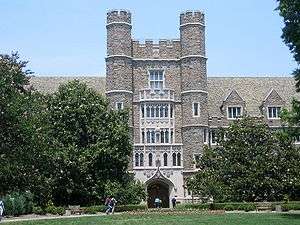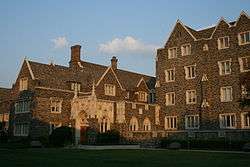Duke University School of Medicine
| Type | Private |
|---|---|
| Established | 1930 |
Parent institution | Duke University |
| Dean | Mary E. Klotman, MD |
Academic staff | 2,200+ |
| Students | 450 |
| Location |
Durham, North Carolina, United States 36°00′03″N 78°56′25″W / 36.0007°N 78.9403°WCoordinates: 36°00′03″N 78°56′25″W / 36.0007°N 78.9403°W |
| Campus | Urban |
| Website |
medschool |
The Duke University School of Medicine along with the Duke University School of Nursing and Duke University Health System create Duke Health. Established in 1925 by James B. Duke, the School of Medicine has earned its reputation as an integral part of one of the world's foremost patient care and biomedical research institutions.
Clinical rotations by medical students and residents occur within the Duke University Health System, a fully integrated academic health care system encompassing a tertiary-care hospital and specialty clinics on the Medical Center campus, two community hospitals, a VA hospital, home health and hospice services, a network of primary care physicians, and other affiliated partners across the SE United States. Duke University Hospital is consistently ranked among the top 10 of some 5,700 American hospitals by US News and World Report. Furthermore, the School of Medicine is especially noted for its groundbreaking biomedical research, bringing in nearly $700 million in NIH-sponsored projects in 2016.
History

In 1925, James B. Duke made a bequest to establish the Duke School of Medicine, Duke School of Nursing, and Duke Hospital, with the goal of improving health care in the Carolinas and nationwide. Three thousand applicants applied to the new medical school in 1929 and 70 first- and third-year students were selected, including four women, for the School's inaugural class. In 1935, just five years after it opened, Duke was ranked among the top 25 percent of medical schools in the country by the AAMC.
Timeline of select research and patient care milestones
1937 Barnes Woodall establishes the nation's first brain tumor program.
1968 Robert Lefkowitz describes the adrenaline receptor.
1972 Child safety cap requirements championed by Jay Arena enacted as federal law.
1982 Pediatric immunologist Rebecca Buckley uses bone marrow transplantation to restore the immune systems of children born with severe combined immunodeficiency, also known as bubble boy disease.
1984 Bart Haynes contributes to the identification of HTLV-III, now known as HIV.
1990 Joanne Kurtzberg establishes the Duke Pediatric Blood and Marrow Transplant Program.
1994 Dr. Louise Markert demonstrates that babies born with no immune system, a fatal condition known as complete DiGeorge syndrome, can be cured with thymus transplantation.
1995 Duke scientists link the BRCA1 and BRCA2 genes to breast and ovarian cancers.
2001 Miguel Nicolelis develops a system that allows monkeys to control robot arms via brain signals, an important step to enable paralyzed people to control "neuroprosthetic" limbs.
2006 YT Chen and Priya Kishnani develop Myozyme as the first treatment for Pompe’s disease.
2011 Hai Yan leads a team of scientists from Duke and Johns Hopkins universities to identify mutations in a gene that makes cells immortal and appear to play a pivotal role in three of the most common types of brain tumors, as well as cancers of the liver, tongue and urinary tract.
2013 Duke researcher Jeffery Lawson and Dr. Laura Niklason of Yale School of Medicine, develop a bioengineered blood vessel, which Lawson grafted into an artery in a Duke patient’s arm, the first in-human procedure of its kind in the United States.
Rankings and admissions
According to US News and World Report, the Duke University School of Medicine consistently ranks in the top ten medical schools in the United States.[1]
Admission to the school's medical degree program is highly competitive, with more than 7,500 applicants for approximately 115 openings each year. The school ranks very highly among its peers in the diversity of its medical students. Among the draws of the program is its unique curriculum, which gives students contact with patients a year earlier than at most other medical schools and includes an entire year devoted to independent research. Many students use the year to begin studies toward a second degree; nearly one-quarter earn a PhD, Master of Public Health (MPH), MBA, JD, or master's degree in addition to an MD. About 19.5 percent are enrolled in Duke's Medical Scientist Training Program, which leads to both an MD and a PhD in health-related basic biomedical or social science research. Created to train highly qualified students as physician-scientists, the Duke program is the fourth oldest in the country, has been continuously funded by the NIH for almost 50 years, and is highly regarded nationally.
Duke University School of Medicine also includes PhD programs in the basic sciences and education and training programs in other health professions, including the top-ranked Physician Assistant and Doctor of Physical Therapy programs, a Primary Care Leadership Track, Master of Biomedical Sciences, MS and PhD in Biostatistics, and Master of Management in Clinical Informatics.
Collaboration with the National University of Singapore
Duke opened a medical school collaboration with the National University of Singapore. The Duke-NUS Graduate Medical School graduated their first class in 2011.[2] The curriculum is similar in structure though the Duke-NUS campus focuses heavily on their team-based learning method called TeamLEAD (Learn, Engage, Apply, Develop).[3]
Affiliated research institutions


- The Duke Clinical Research Institute (DCRI) performs all aspects of clinical research ranging from: Phase I through Phase IV clinical trials; outcomes research; registries of more than 100,000 patients; clinical research networks such as the Pediatric Trials Network; and economic and quality of life studies in populations spanning more than 20 therapeutic areas.[4][5] It is home to the Duke Databank for Cardiovascular Diseases, the largest and oldest institutional cardiovascular database in the world, which continues to inform clinical decision-making 40 years after its founding.[6]
- The Duke Global Health Institute (DGHI)' works to reduce health disparities in the local community and worldwide. It brings together interdisciplinary teams to solve complex health problems and to train the next generation of global health scholars. The institute works with faculty and students from every school at Duke. It coordinates educational programs for undergraduate, graduate and professional students and facilitates multi-disciplinary education, research and service efforts on campus and in a variety of international sites.
- The Trent Center for Bioethics, Humanities, and History of Medicine, the Center for Chemical Biology, and the Institute for Genome Sciences & Policy.
- Sarah W. Stedman Nutrition and Metabolism Center. Research efforts include translating basic science and epidemiological findings into well-designed clinical trials, ultimately leading to the development of new therapies for diseases with a metabolic basis such as obesity, diabetes, heart disease, and cancer.
- The Duke Human Vaccine Institute (DHVI) is a national and international leader in the fight against the major infectious diseases. Institute leaders head the $45-million Southeast Regional Center of Excellence for Emerging Infections and Biodefense (SERCEB), established by the NIH and U.S. Department of Health and Human Services in 2003 to perform the basic and translational research to make drugs, vaccines, and diagnostics to protect society from emerging infections and biothreats.
- The Duke Cancer Institute is known for designing innovative therapies using bone marrow transplantation and hyperthermia therapy, for its studies of the immune responses to tumors, and for its treatment of brain tumors, melanoma, lung cancer, breast cancer, ovarian cancer, and prostate cancer.
- The Duke Heart Center has conducted many of the leading studies on the genetic factors underlying heart disease and early trials of new treatments for heart disease, as well as a long-term federal project to define appropriate treatment for heart attack patients.
- The Duke Center for the Study of Aging and Human Development is conducting one of the nation's largest studies of the elderly, surveying over 4,000 people annually to identify risk factors that lead to chronic disease and loss of independence.
- Duke Integrative Medicine is a pioneer in the attempt to examine and quantify the value of mind-body-spirit interventions for the treatment of chronic heart failure.[7]
Notable faculty and alumni
- David H. Adams, heart valve surgery and mitral valve repair
- Raymond Delacy Adams, neurologist and Fellow of the American Academy of Arts and Sciences
- Lenox Baker, physician, public servant
- Charles E. Brady Jr., astronaut
- Julie Story Byerley Pediatrician and Vice Dean for Education for the University of North Carolina at Chapel Hill School of Medicine[8]
- Robert Califf, former commissioner at the Food and Drug Administration
- Irwin Fridovich, biochemist who discovered superoxide dismutase
- Eugene Gu, fetal tissue researcher and CEO of Ganogen Research Institute[9]
- Philip Handler, biochemist and twice President of the National Academy of Sciences
- Abigail Johnston, Olympic silver medalist in diving, competed in 2012 games as a Duke undergraduate and 2016 games while a medical student at Duke
- John G. Kelton, hematologist and Dean of the McMaster University Medical School and McMaster Faculty of Health Sciences, developed a diagnostic test for heparin-induced thrombocytopenia
- Samuel Katz, developer of measles vaccine and recipient of the Albert B. Sabin Gold Medal
- Robert Lefkowitz, physician and biochemist who received the National Medal of Science and the 2012 Nobel Prize in Chemistry
- Sarah Lisanby, Transcranial magnetic stimulation pioneer and Chair of the School's Department of Psychiatry and Behavioral Sciences
- Paul Modrich, biochemist and member of the National Academy of Sciences who received the 2015 Nobel Prize in Chemistry
- Ron Paul, physician (OB/GYN), United States Congressman from Texas
- Rand Paul, surgeon (ophthalmologist), United States Senator from Kentucky and candidate for the United States Presidential election in 2016
- Jane S. Richardson, biochemist and innovator of ribbon drawings as well as winner of MacArthur Award
- Peter Agre, physician and molecular biologist who received the 2003 Nobel Prize in Chemistry
- Brian Kobilka, physician and biochemist who received the 2012 Nobel Prize in Chemistry
- James Young (physician), USN Captain, White House physician to Presidents John F. Kennedy and Lyndon B. Johnson
- David Sabiston Chairman of Surgery, author of authoritative widely used textbook of surgery, performed a seminal procedure that paved the way for modern coronary-bypass surgery, grafting a vein from a patient's leg to bypass a blocked coronary artery during open-heart surgery. Legendary surgical educator
- James Wyngaarden - Chairman of Internal Medicine, long time editor of Cecil's Textbook of Medicine and also The Metabolic Basis of Inherited Disease, Director of the National Institutes of Health(NIH), cofounder of Human Genome Project
- Eugene Stead-Chairman of Internal Medicine. His work paved way for development of cardiac catheterization. He oversaw development of nation's first Physician's Assistant (PA) program
- Peter Cotton- Professor of Medicine. British Gastroenterologist best known for his advancement in digestive disease, pioneering and naming the ERCP procedure.
- Ivan W. Brown collaborating with Will C. Sealy, W. Glenn Young Jr and Wirt W. Smith, developed the heat exchanger used to cool patients through countercurrent heat exchange within the cardiopulmonary bypass circuit. This remains an integral component of managing cardiopulmonary bypass, replacing patient immersion cooling and surface rewarming.
- Nancy C. Andrews- Pioneer in iron homeostasis. Dean, Duke University School of Medicine
- Darell Bigner director of the Preston Robert Tisch Brain Tumor Center at Duke. Pioneering immuno therapy using inactivated polio virus to treat brain tumors
References
- ↑ "Archived copy". Archived from the original on 2012-04-15. Retrieved 2012-04-19.
- ↑ Kamei, Cook; Puthucheary, Starmer (2012). "21st Century Learning in Medicine: Traditional Teaching versus Team-Based Teaching". Medical Science Educator. 22 (2). Archived from the original on 2013-11-04. Retrieved 2013-08-01.
- ↑ staff. "AAMC Readiness for Reform: Duke – National University of Singapore Case Study Implementing Team-Based Learning for Medical Students" (PDF). Association of American Medical Colleges. Archived from the original (PDF) on 2013-11-04. Retrieved 2013-08-01.
- ↑ Duke Medicine. "Research". Duke School of Medicine. Archived from the original on 11 November 2013. Retrieved 3 February 2014.
- ↑ Duke Clinical Research Institute. "DCRI Stats". Retrieved 3 February 2014.
- ↑ Duke Center for Health Informatics. "Duke Databank for Cardiovascular Disease" (PDF). Retrieved 3 February 2014.
- ↑ Eisenberg, Seth. "Studies Offer Insights into Value, Principles of Evidence-Based Relationship Skills Training," Fatherhood Channel, January 20, 2013.
- ↑ "Byerley appointed Vice Dean for Education". Vital Signs. UNC Health Care News. 2013-09-12. Retrieved 2015-04-13.
- ↑ http://www.sciencefriday.com/person/eugene-gu/
